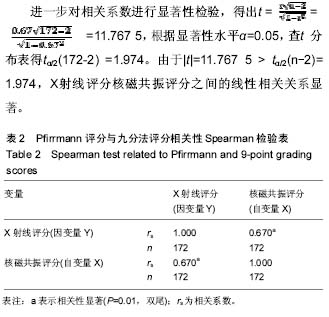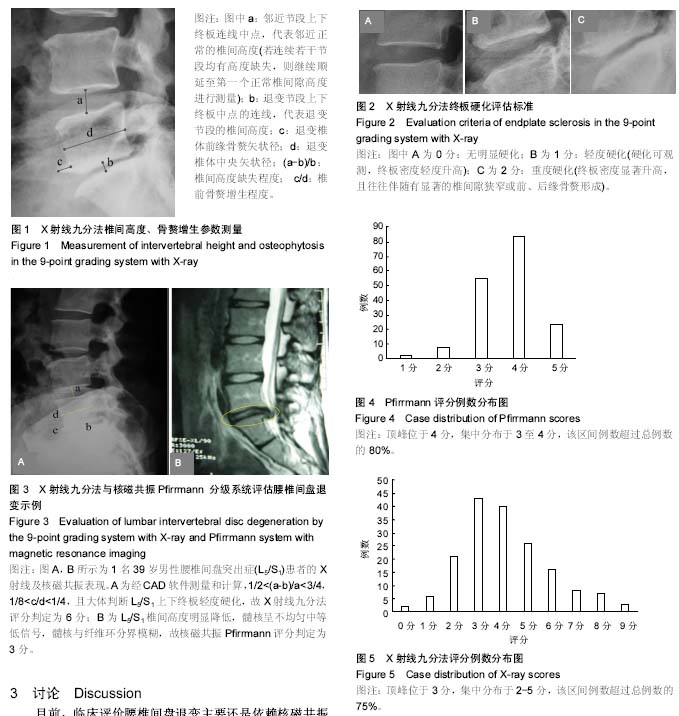| [1] Yu LP, Qian WW, Yin GY, et al. MRI assessment of lumbar intervertebral disc degeneration with lumbar degenerative disease using the Pfirrmann grading systems. PLoS One. 2012;7(12):e48074.[2] Peter G, Katherine D, Michael R, et al. Assessment of intervertebral disc degeneration based on quantitative MRI analysis: an in vivo study. Spine. 2014;39(6):e369-378.[3] Desai MJ, Hargens LM, Breitenfeldt MD, et al. The rate of magnetic resonance imaging in patients with spinal cord stimulation.Spine (Phila Pa 1976). 2015; 40(9): E531-E537.[4] Arnbak B, Jensen RK, Manniche C, et al. Identification of subgroups of inflammatory and degenerative MRI findings in the spine and sacroiliac joints: a latent class analysis of 1037 patients with persistent low back pain.Arthritis Res Ther. 2016; 18: 237.[5] Pfirrmann CW, Metzdorf A, Zanetti M, et al. Magnetic resonance classification of lumbar intervertebral disc degeneration. Spine. 2001;26(17):1873-1878.[6] Muriuki MG, Havey RM, Voronov LI, et al. Effects of motion segment level, Pfirrmann intervertebral disc degeneration grade and gender on lumbar spine kinematics. J Orthop Res. 2016;34(8):1389-1398.[7] Weber U, Pfirrmann CWA, Kissling RO, et al. Whole body MR imaging in ankylosing spondylitis: a descriptive pilot study in patients with suspected early and active confirmed ankylosing spondylitis.BMC Musculoskelet Disord. 2007;8:20.[8] Urrutia J, Besa P, Campos M, et al. The Pfirrmann classification of lumbar intervertebral disc degeneration: an independent inter- and intra-observer agreement assessment. Eur Spine J. 2016;25(9):2728-2733.[9] Leite MS, Luciano RP, Martins DE, et al. Correlation between Pfirrmann and Modic classifications in the degeneration of lumbar intervertebral disc. Coluna/Columna. 2010;9(4): 401-406.[10] Bergknut N, Auriemma E, Wijsman S, et al. Evaluation of intervertebral disk degeneration in chondrodystrophic and nonchondrodystrophic dogs by use of Pfirrmann grading of images obtained with low-field magnetic resonance imaging. Am J Vet Res. 2011;72(7):893-898.[11] Wei W, Jin H, Deyong L, et al. Multimodal quantitative magnetic resonance imaging for lumbar intervertebral disc degeneration. Exp Ther Med. 2017;14(3):2078-2084.[12] Smith GW, Robinson RA. The treatment of certain cervical-spine disorders by anterior removal of the intervertebral disc and interbody fusion. J Bone Joint Surg Am. 1958;40(3):607-624.[13] Oglesby M1, Fineberg SJ, Patel AA, et al. Epidemiological trends in cervical spine surgery for degenerative diseases between 2002 and 2009. Spine. 2013;38(14):1226-1232.[14] Baldwin A, Mesfin A. Adjacent segment disease 44 years following posterior spinal fusion for congenital lumbar kyphosis. Spine Deform. 2017;5(6):435-439.[15] Dong L, Xu Z, Chen X, et al. The change of adjacent segment after cervical disc arthroplasty compared with anterior cervical discectomy and fusion: a meta-analysis of randomized controlled trials. Spine J. 2017;17(10):1549-1558.[16] 姜允琦,李熙雷,董健.腰椎融合术后邻椎病发生的危险因素[J].中华医学杂志. 2012;92(29):2078-2080.[17] Sears WR, Sergides IG, Kazemi N, et al. Incidence and prevalence of surgery at segments adjacent to a previous posterior lumbar arthrodesis. Spine J. 2011;11(1):11-20.[18] Cho KS, Kang SG, Yoo DS, et al. Risk factors and surgical treatment for symptomatic adjacent segment degeneration after lumbar spine fusion. J Korean Neurosurg Soc. 2009; 46(5):425-430.[19] Lee CS, Hwang CJ, Lee SW, et al. Risk factors for adjacent segment disease after lumbar fusion. Eur Spine J. 2009; 18(11):1637-1643.[20] Hilibrand AS, Robbins M. Adjacent segment degeneration and adjacent segment disease: the consequences of spinal fusion? Spine J. 2004;4(6 Suppl):190-194.[21] Benneker LM, Heini PF, Anderson SE, et al. Correlation of radiographic and MRI parameters to morphological and biochemical assessment of intervertebral disc degeneration. Eur Spine J. 2005;14(1):27-35.[22] Walraevens J, Liu B, Meersschaert J, et al. Qualitative and quantitative assessment of degeneration of cervical intervertebral discs and facet joints. Eur Spine J. 2009; 18(3):358-369.[23] 于斌,王以朋,邱贵兴.腰椎间盘退变的MRI分级评价方法研究进展[J].中国骨与关节外科杂志. 2010;3(5):410-413.[24] Schneiderman G, Flannigan B, Kingston S, et al.Magnetic resonance imaging in the diagnosis of disc degeneration: correlation with discography. Spine. 1987;12:276-281.[25] Luoma K, Vehmas T, Riihimäki H, etal. Disc height and signal intensity of the nucleus pulposus on magnetic resonance imaging as indicators of lumbar disc degeneration. Spine. 2001;26(6):680-686.[26] Videman T, Nummi P, Battié MC, et al. Digital assessment of MRI for lumbar disc desiccation. A comparison of digital versus subjective assessments and digital intensity profiles versus discogram and macroanatomic findings. Spine.1994; 19(2):192-198.[27] Thompson JP, Pearce RH, Schechter MT, et al. Preliminary evaluation of a scheme for grading the gross morphology of the human intervertebral disc. Spine.1990;15(5):411-415.[28] Griffith JF, Wang YX, Antonio GE, et al. Modified Pfirrmann grading system for lumbar intervertebral disc degeneration. Spine. 2007;32(24):e708-712.[29] Edmondston SJ, Song S, Bricknell RV, et al. MRI evaluation of lumbar spine flexion and extension in asymptomatic individuals. Man Ther. 2000;5(3):158-164.[30] Campana S, Charpail E, De Guise JA, et al. Relationships between viscoelastic properties of lumbar intervertebral disc and degeneration grade assessed by MRI. J Mech Behav Biomed Mater. 2011;4(4):593-599.[31] Niinimäki J, Korkiakoski A, Ojala O, et al. Association between visual degeneration of intervertebral discs and the apparent diffusion coefficient. Magn Reson Imaging. 2009;27(5): 641-647.[32] Zuo J, Saadat E, Romero A, et al. Assessment of intervertebral disc degeneration with magnetic resonance single-voxel spectroscopy. Magn Reson Med. 2009;62(5): 1140-1146.[33] Xiao L, Ni C, Shi J, et al. Analysis of correlation between vertebral endplate change and lumbar disc degeneration. Med Sci Monit. 2017;23:4932-4938.[34] Hausmann ON,Böni T,Pfirrmann CWA, et al. Preoperative radiological and electrophysiological evaluation in 100 adolescent idiopathic scoliosis patients.Eur Spine J. 2003; 12(5): 501-506.[35] Young KJ. Gimme that old time religion: the influence of the healthcare belief system of chiropractic’s early leaders on the development of x-ray imaging in the profession.Chiropr Man Therap. 2014; 22: 36.[36] Tannor AY. Lumbar spine X-ray as a standard investigation for all low back pain in Ghana: is it evidence based? Ghana Med J. 2017; 51(1): 24-29.[37] Peterfy CG, DiCarlo JC, Olech E, et al. Evaluating joint-space narrowing and cartilage loss in rheumatoid arthritis by using MRI.Arthritis Res Ther. 2012;14(3): R131. |
.jpg)


.jpg)
.jpg)